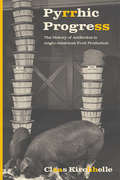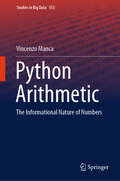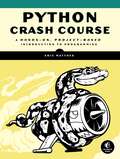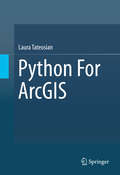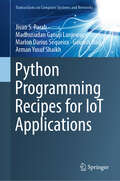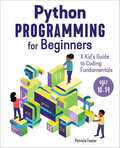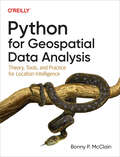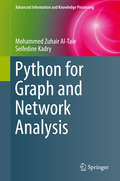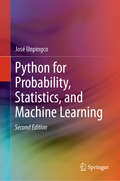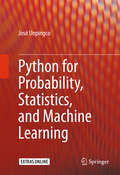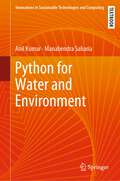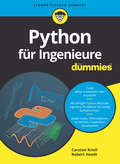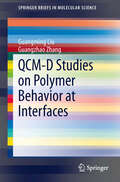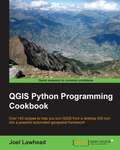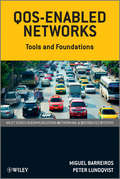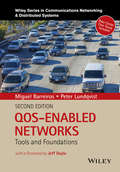- Table View
- List View
Pyrochlore Oxides: Structure, Properties, and Potential in Photocatalytic Applications (Green Chemistry and Sustainable Technology)
by Diana G. Fukina Artem S. Belousov Evgeny V. SuleimanovThis book presents an in-depth exploration of complex metal oxides, focusing on their applications in photocatalysis and biomedical materials. It highlights the practical importance of complex metal oxides, which have gained significant attention in recent years due to their diverse range of properties. The book specifically delves into the most representative series of compounds based on stable structural types of minerals, such as perovskite, fluorite, pyrochlore, corundum, and rutile. It also emphasizes the scientific interest in the pyrochlore mineral structure, which has been shown to exhibit photocatalytic activity.Recent studies have revealed that some compounds with the pyrochlore structure can act as promising candidates for photocatalysis. Additionally, the book highlights the use of photocatalysis in producing biomedical materials based on natural polymers. These materials possess a unique combination of components assembled in a specific structure, which makes them highly attractive for regenerative medicine associated with cell/tissue regeneration stimulation. Overall, this book offers a comprehensive analysis of the potential of complex metal oxides, particularly those with the pyrochlore structure, and is particularly useful for those researchers working in the fields of green chemistry and biomedical materials science.
Pyroelectric Materials: Physics and Applications
by Ashim Kumar Bain Prem ChandPyroelectric Materials An authoritative and practical discussion of pyroelectric materials and their applications In Pyroelectric Materials: Physics and Applications, the authors deliver a comprehensive exploration of the physics of pyroelectric materials and their applications. With authoritative coverage of a wide variety of critical topics in the field, the authors provide the readers with chapters on dielectric fundamentals, pyroelectricity, pyroelectric materials and their applications such as pyroelectric infrared detectors, pyroelectric energy harvesting, and pyroelectric fusion. Readers will also find: A thorough introduction to the fundamentals of dielectrics, including discussions of polarization, dispersion, relaxation, and the molecular theory of induced charges in a dielectric Comprehensive explorations of pyroelectricity, including its history, theory, and a simple model of pyroelectric effect Perfect for researchers and professionals with an interest in pyroelectric materials, the book is also useful for graduate students taking courses involving pyroelectric materials and their applications.
Pyrrhic Progress: The History of Antibiotics in Anglo-American Food Production (Critical Issues in Health and Medicine)
by Claas KirchhellePyrrhic Progress analyses over half a century of antibiotic use, regulation, and resistance in US and British food production. Mass-introduced after 1945, antibiotics helped revolutionize post-war agriculture. Food producers used antibiotics to prevent and treat disease, protect plants, preserve food, and promote animals’ growth. Many soon became dependent on routine antibiotic use to sustain and increase production. The resulting growth of antibiotic infrastructures came at a price. Critics blamed antibiotics for leaving dangerous residues in food, enabling bad animal welfare, and selecting for antimicrobial resistance (AMR) in bacteria, which could no longer be treated with antibiotics. Pyrrhic Progress reconstructs the complicated negotiations that accompanied this process of risk prioritization between consumers, farmers, and regulators on both sides of the Atlantic. Unsurprisingly, solutions differed: while Europeans implemented precautionary antibiotic restrictions to curb AMR, consumer concerns and cost-benefit assessments made US regulators focus on curbing drug residues in food. The result was a growing divergence of antibiotic stewardship and a rise of AMR. Kirchhelle’s comprehensive analysis of evolving non-human antibiotic use and the historical complexities of antibiotic stewardship provides important insights for current debates on the global burden of AMR.
Pythium: Diagnosis, Diseases and Management
by Mahendra Rai Avinash P. Ingle Kamel A. Abd-ElsalamPythium is one of the most important phytopathogens causing significant damage to agriculture, forest, and nurseries, etc. It is an unseen enemy of the root zone of various plants and hence considered as "hidden terror" for a number of plants. An accurate diagnosis and identification of Pythium causing various infections in plants is very important because it is often confused with several other fungi. Pythium infections are difficult to control once they have set in. Therefore, its effective and ecofriendly management is of paramount importance. In addition, there are many reports on Pythium causing infections in human beings and animals. The present book on Pythium focuses on various aspects which mainly include pathogenesis, technological developments in detection and diagnosis, and its management. Key Features Includes identification of Pythium spp. by traditional and molecular methods Deals with different diseases caused by Pythium spp Describes the role of Pythium in mammalian diseases Incorporates various management strategies Discusses emerging role of nanotechnological tools for the management of Pythium diseases
Python Arithmetic: The Informational Nature of Numbers (Studies in Big Data #153)
by Vincenzo MancaThe book is a gentle introduction to Python using arithmetic, and vice versa, with a historical perspective encompassing programming languages within the wider process of development of mathematical notation. The revisitation of typical algorithms that are the core of elementary mathematical knowledge helps to grasp their essence and to clarify some assumptions that are often taken for granted but are very profound and of a very general nature. The first mathematician to define a systematic system for generating numbers was Archimedes of Syracuse in the third century B.C. The Archimedean system, which was defined in a book with the Latin title Arenarius, was not intended to define all numbers, but only very large numbers [13, 22, 23]. However, it can be considered the first system with the three main characteristics of a counting system that have the most important properties for complete arithmetic adequacy: creativity, infinity, and recursion. Creativity means that each numeral is new for numerals that precede it; infinity means that after any numeral there is always another numeral; recursion means that after an initial sequence of numerals coinciding with the digits of the system, digits repeat regularly in all subsequent numerals. Since the numerals are finite expressions of digits, their lengths increase along their generation. In the next chapter, Python is briefly introduced by linking this language to standard mathematical notation, which took its current form throughout a long process that extends from the introduction of decimal numerals to the eighteenth century, particularly within Euler’s notational and conceptual framework. The third chapter is devoted to counting algorithms, showing that something that is usually taken for granted has intriguing aspects that deserve a very subtle analysis: the authors will show that the Python representation of counting algorithms is very informative and demonstrates the informational nature of numbers.
Python Crash Course: A Hands-On, Project-Based Introduction to Programming
by Eric MatthesPython Crash Course is a fast-paced, thorough introduction to Python that will have you writing programs, solving problems, and making things that work in no time.In the first half of the book, you’ll learn about basic programming concepts, such as lists, dictionaries, classes, and loops, and practice writing clean and readable code with exercises for each topic. You’ll also learn how to make your programs interactive and how to test your code safely before adding it to a project. In the second half of the book, you’ll put your new knowledge into practice with three substantial projects: a Space Invaders–inspired arcade game, data visualizations with Python’s super-handy libraries, and a simple web app you can deploy online.As you work through Python Crash Course you’ll learn how to:–Use powerful Python libraries and tools, including matplotlib, NumPy, and Pygal–Make 2D games that respond to keypresses and mouse clicks, and that grow more difficult as the game progresses–Work with data to generate interactive visualizations–Create and customize Web apps and deploy them safely online–Deal with mistakes and errors so you can solve your own programming problemsIf you’ve been thinking seriously about digging into programming, Python Crash Course will get you up to speed and have you writing real programs fast. Why wait any longer? Start your engines and code!Uses Python 2 and 3
Python For ArcGIS
by Laura TateosianThis book introduces Python scripting for geographic information science (GIS) workflow optimization using ArcGIS. It builds essential programming skills for automating GIS analysis. Over 200 sample Python scripts and 175 classroom-tested exercises reinforce the learning objectives. Readers will learn to: * Write and run Python in the ArcGIS Python Window, the PythonWin IDE, and the PyScripter IDE * Work with Python syntax and data types * Call ArcToolbox tools, batch process GIS datasets, and manipulate map documents using the arcpy package * Read and modify proprietary and ASCII text GIS data * Parse HTML web pages and KML datasets * Create Web pages and fetch GIS data from Web sources. * Build user-interfaces with the native Python file dialog toolkit or the ArcGIS Script tools and PyToolboxes Python for ArcGIS is designed as a primary textbook for advanced-level students in GIS. Researchers, government specialists and professionals working in GIS will also find this book useful as a reference.
Python Programming Recipes for IoT Applications (Transactions on Computer Systems and Networks)
by Jivan S. Parab Gourish Naik Madhusudan Ganuji Lanjewar Marlon Darius Sequeira Arman Yusuf ShaikhThe book comprehensively covers the most important applications of the internet of things (IoT) using Python programming on Raspberry pi, Micropython Py Board, and NVIDIA Jetson Board. The authors have used an immersive ‘hands-on’ approach to help readers gain expertise in developing working code for real-world IoT applications. The book focuses on industry-standard embedded platforms for IoT applications. It also gives a glimpse of python programming and setup configuration of these embedded platforms. The later chapter highlights basic interface applications with Raspberry Pi. Exclusive advanced IoT applications on the Micropython Pyboard are also covered. The last two chapters deal with the NVIDIA Jetson Nano board programming for machine learning applications with FoG/cloud computing. The various IoT applications with different embedded platforms in this volume are best-suited for undergraduate/postgraduate students and researchers who want to get exposed to python programming for IoT applications. This book will enable readers to design their own embedded IoT products.
Python Programming for Beginners: A Kid's Guode to Coding Fundamentals
by Patricia FosterThink like a programmer with this fun beginner's guide to Python for ages 10 to 14Kids can learn to code with the power of Python! Python Programming for Beginners is the perfect way to introduce aspiring coders to this simple and powerful coding language. This book teaches kids all about Python and programming fundamentals—and is packed full of fun and creative activities that make learning a blast!In Python Programming for Beginners, kids will start off with the basics, learning all about fundamental coding concepts and how they can put these concepts together in Python to build their own games and programs. Each chapter focuses on a different coding concept—like variables, data types, and loops—and features three awesome coding activities to try. These activities get more difficult as they go, so young coders can see just how much their skills are growing. By the end of Python Programming for Beginners, they'll create their own fully functional sci-fi game and crack the code to a secret message!Python Programming for Beginners features:No coding experience needed!—Designed just for kids, this Python programming book is filled with step-by-step directions, simple explanations, and detailed code breakdowns.Build a coding toolbox—Kids will build their programming skills, learn how to troubleshoot bugs with a handy bug-hunting guide, and practice their Python programming knowledge with cool activities.Why Python programming?—Python is an awesome starting language for kids! It's a powerful programming language that can be used for lots of projects but features simple syntax so beginners can focus on learning programming logic.Set kids up for a lifetime of programming success with Python Programming for Beginners .
Python Programming for Data Analysis
by José UnpingcoThis textbook grew out of notes for the ECE143 Programming for Data Analysis class that the author has been teaching at University of California, San Diego, which is a requirement for both graduate and undergraduate degrees in Machine Learning and Data Science. This book is ideal for readers with some Python programming experience. The book covers key language concepts that must be understood to program effectively, especially for data analysis applications. Certain low-level language features are discussed in detail, especially Python memory management and data structures. Using Python effectively means taking advantage of its vast ecosystem. The book discusses Python package management and how to use third-party modules as well as how to structure your own Python modules. The section on object-oriented programming explains features of the language that facilitate common programming patterns.After developing the key Python language features, the book moves on to third-party modules that are foundational for effective data analysis, starting with Numpy. The book develops key Numpy concepts and discusses internal Numpy array data structures and memory usage. Then, the author moves onto Pandas and details its many features for data processing and alignment. Because strong visualizations are important for communicating data analysis, key modules such as Matplotlib are developed in detail, along with web-based options such as Bokeh, Holoviews, Altair, and Plotly.The text is sprinkled with many tricks-of-the-trade that help avoid common pitfalls. The author explains the internal logic embodied in the Python language so that readers can get into the Python mindset and make better design choices in their codes, which is especially helpful for newcomers to both Python and data analysis. To get the most out of this book, open a Python interpreter and type along with the many code samples.
Python Web Scraping, Second Edition
by Katharine Jarmul Richard LawsonSuccessfully scrape data from any website with the power of Python 3.xAbout This Book* A hands-on guide to web scraping using Python with solutions to real-world problems* Create a number of different web scrapers in Python to extract information* This book includes practical examples on using the popular and well-maintained libraries in Python for your web scraping needsWho This Book Is ForThis book is aimed at developers who want to use web scraping for legitimate purposes. Prior programming experience with Python would be useful but not essential. Anyone with general knowledge of programming languages should be able to pick up the book and understand the principals involved.What You Will Learn* Extract data from web pages with simple Python programming* Build a concurrent crawler to process web pages in parallel* Follow links to crawl a website* Extract features from the HTML* Cache downloaded HTML for reuse* Compare concurrent models to determine the fastest crawler* Find out how to parse JavaScript-dependent websites* Interact with forms and sessionsIn DetailThe Internet contains the most useful set of data ever assembled, most of which is publicly accessible for free. However, this data is not easily usable. It is embedded within the structure and style of websites and needs to be carefully extracted. Web scraping is becoming increasingly useful as a means to gather and make sense of the wealth of information available online.This book is the ultimate guide to using the latest features of Python 3.x to scrape data from websites. In the early chapters, you'll see how to extract data from static web pages. You'll learn to use caching with databases and files to save time and manage the load on servers. After covering the basics, you'll get hands-on practice building a more sophisticated crawler using browsers, crawlers, and concurrent scrapers.You'll determine when and how to scrape data from a JavaScript-dependent website using PyQt and Selenium. You'll get a better understanding of how to submit forms on complex websites protected by CAPTCHA. You'll find out how to automate these actions with Python packages such as mechanize. You'll also learn how to create class-based scrapers with Scrapy libraries and implement your learning on real websites.By the end of the book, you will have explored testing websites with scrapers, remote scraping, best practices, working with images, and many other relevant topics.Style and approachThis hands-on guide is full of real-life examples and solutions starting simple and then progressively becoming more complex. Each chapter in this book introduces a problem and then provides one or more possible solutions.
Python for Everybody: Exploring Data Using Python 3
by Dr Charles R. SeverancePython for Everybody: Exploring Data Using Python 3
Python for Geospatial Data Analysis: Theory, Tools, and Practice for Location Intelligence
by Bonny P. McClainIn spatial data science, things in closer proximity to one another likely have more in common than things that are farther apart. With this practical book, geospatial professionals, data scientists, business analysts, geographers, geologists, and others familiar with data analysis and visualization will learn the fundamentals of spatial data analysis to gain a deeper understanding of their data questions.Author Bonny P. McClain demonstrates why detecting and quantifying patterns in geospatial data is vital. Both proprietary and open source platforms allow you to process and visualize spatial information. This book is for people familiar with data analysis or visualization who are eager to explore geospatial integration with Python.This book helps you:Understand the importance of applying spatial relationships in data scienceSelect and apply data layering of both raster and vector graphicsApply location data to leverage spatial analyticsDesign informative and accurate mapsAutomate geographic data with Python scriptsExplore Python packages for additional functionalityWork with atypical data types such as polygons, shape files, and projectionsUnderstand the graphical syntax of spatial data science to stimulate curiosity
Python for Graph and Network Analysis
by Seifedine Kadry Mohammed Zuhair Al-TaieThis research monograph provides the means to learn the theory and practice of graph and network analysis using the Python programming language. The social network analysis techniques, included, will help readers to efficiently analyze social data from Twitter, Facebook, LiveJournal, GitHub and many others at three levels of depth: ego, group, and community. They will be able to analyse militant and revolutionary networks and candidate networks during elections. For instance, they will learn how the Ebola virus spread through communities. Practically, the book is suitable for courses on social network analysis in all disciplines that use social methodology. In the study of social networks, social network analysis makes an interesting interdisciplinary research area, where computer scientists and sociologists bring their competence to a level that will enable them to meet the challenges of this fast-developing field. Computer scientists have the knowledge to parse and process data while sociologists have the experience that is required for efficient data editing and interpretation. Social network analysis has successfully been applied in different fields such as health, cyber security, business, animal social networks, information retrieval, and communications.
Python for Kids, 2nd Edition: A Playful Introduction to Programming
by Jason R. BriggsThe second edition of the best-selling Python for Kids—which brings you (and your parents) into the world of programming—has been completely updated to use the latest version of Python, along with tons of new projects!Python is a powerful, expressive programming language that&’s easy to learn and fun to use! But books about learning to program in Python can be dull and gray—and that&’s no fun for anyone.Python for Kids brings Python to life and brings kids (and their parents) into the wonderful world of programming. Author Jason R. Briggs guides readers through the basics, experimenting with unique (and often hilarious) example programs that feature ravenous monsters, secret agents, thieving ravens, and more. New terms are defined; code is colored, dissected, and explained; and quirky, full-color illustrations keep things fun and engaging throughout.Chapters end with programming puzzles designed to stretch the brain and strengthen understanding. By the end of the book, young readers will have programmed two complete games: a clone of the famous Pong, and &“Mr. Stick Man Races for the Exit&”—a platform game with jumps, animation, and much more.This second edition has been completely updated and revised to reflect the latest Python version and programming practices, with new puzzles to inspire readers to take their code farther than ever before. Why should serious adults have all the fun? Python for Kids is the ticket into the amazing world of computer programming.
Python for Probability, Statistics, and Machine Learning
by José UnpingcoThis textbook, fully updated to feature Python version 3.7, covers the key ideas that link probability, statistics, and machine learning illustrated using Python modules. The entire text, including all the figures and numerical results, is reproducible using the Python codes and their associated Jupyter/IPython notebooks, which are provided as supplementary downloads. The author develops key intuitions in machine learning by working meaningful examples using multiple analytical methods and Python codes, thereby connecting theoretical concepts to concrete implementations. The update features full coverage of Web-based scientific visualization with Bokeh Jupyter Hub; Fisher Exact, Cohen’s D and Rank-Sum Tests; Local Regression, Spline, and Additive Methods; and Survival Analysis, Stochastic Gradient Trees, and Neural Networks and Deep Learning. Modern Python modules like Pandas, Sympy, and Scikit-learn are applied to simulate and visualize important machine learning concepts like the bias/variance trade-off, cross-validation, and regularization. Many abstract mathematical ideas, such as convergence in probability theory, are developed and illustrated with numerical examples. This book is suitable for classes in probability, statistics, or machine learning and requires only rudimentary knowledge of Python programming.
Python for Probability, Statistics, and Machine Learning
by José UnpingcoThis book, fully updated for Python version 3.6+, covers the key ideas that link probability, statistics, and machine learning illustrated using Python modules in these areas. All the figures and numerical results are reproducible using the Python codes provided. The author develops key intuitions in machine learning by working meaningful examples using multiple analytical methods and Python codes, thereby connecting theoretical concepts to concrete implementations. Detailed proofs for certain important results are also provided. Modern Python modules like Pandas, Sympy, Scikit-learn, Tensorflow, and Keras are applied to simulate and visualize important machine learning concepts like the bias/variance trade-off, cross-validation, and regularization. Many abstract mathematical ideas, such as convergence in probability theory, are developed and illustrated with numerical examples. This updated edition now includes the Fisher Exact Test and the Mann-Whitney-Wilcoxon Test. A new section on survival analysis has been included as well as substantial development of Generalized Linear Models. The new deep learning section for image processing includes an in-depth discussion of gradient descent methods that underpin all deep learning algorithms. As with the prior edition, there are new and updated *Programming Tips* that the illustrate effective Python modules and methods for scientific programming and machine learning. There are 445 run-able code blocks with corresponding outputs that have been tested for accuracy. Over 158 graphical visualizations (almost all generated using Python) illustrate the concepts that are developed both in code and in mathematics. We also discuss and use key Python modules such as Numpy, Scikit-learn, Sympy, Scipy, Lifelines, CvxPy, Theano, Matplotlib, Pandas, Tensorflow, Statsmodels, and Keras.This book is suitable for anyone with an undergraduate-level exposure to probability, statistics, or machine learning and with rudimentary knowledge of Python programming.
Python for Signal Processing
by José UnpingcoThis book covers the fundamental concepts in signal processing illustrated with Python code and made available via IPython Notebooks, which are live, interactive, browser-based documents that allow one to change parameters, redraw plots, and tinker with the ideas presented in the text. Everything in the text is computable in this format and thereby invites readers to "experiment and learn" as they read. The book focuses on the core, fundamental principles of signal processing. The code corresponding to this book uses the core functionality of the scientific Python toolchain that should remain unchanged into the foreseeable future. For those looking to migrate their signal processing codes to Python, this book illustrates the key signal and plotting modules that can ease this transition. For those already comfortable with the scientific Python toolchain, this book illustrates the fundamental concepts in signal processing and provides a gateway to further signal processing concepts.
Python for Water and Environment (Innovations in Sustainable Technologies and Computing)
by Anil Kumar Manabendra SahariaThis textbook delves into the practical applications of surface and groundwater hydrology, as well as the environment. The Part I, "Practical Python for a Water and Environment Professional," guides readers through setting up a scientific computing environment and conducting exploratory data analysis and visualization using reproducible workflows. The Part II, "Statistical Modeling in Hydrology," covers regression models, time series analysis, and common hypothesis testing. The Part III, "Surface and Subsurface Water," illustrates the use of Python in understanding key concepts related to seepage, groundwater, and surface water flows. Lastly, the Part IV, "Environmental Applications," demonstrates the application of Python in the study of various contaminant transport phenomena.
Python für Ingenieure für Dummies (Für Dummies)
by Carsten Knoll Robert HeedtSchlichtes Ausführen fertiger Software wird den Bedürfnissen des Ingenieuralltags nicht mehr gerecht. Oft muss Programmcode selbst entwickelt oder angepasst werden. Aber Ingenieure sind keine Softwareentwickler. Mit Python steht ein mächtiger und flexibler Werkzeugkasten zur Verfügung, der es erlaubt, eine große Klasse von Ingenieurproblemen - oft mit wenig Aufwand - zu lösen. Die Kernaufgaben sind dabei meist: Daten akquirieren, Lösungsalgorithmen anwenden, Ergebnisse visualisieren. Das Buch zeigt anhand zahlreicher Beispiele aus unterschiedlichen Anwendungsfeldern der Ingenieurwissenschaften, wie Python zur Lösung dieser Aufgaben eingesetzt werden kann. Gleichzeitig wird das nötige Hintergrundwissen vermittelt, um das Gelernte auf eigene Fragestellungen zu transferieren. Die vermittelten Kenntnisse sind anwendbar auf Übungsaufgaben im Studium genauso wie auf Probleme aus der Praxis.
QCM-D Studies on Polymer Behavior at Interfaces
by Guangming Liu Guangzhao ZhangQCM-D Studies on Polymer Behavior at Interfaces reviews the applications of quartz crystal microbalance with dissipation (QCM-D) in polymer research, including the conformational change of grafted polymer chains, the grafting kinetics of polymer chains, the growth mechanism of polyelectrolyte multilayers, and the interactions between polymers and phospholipid membranes. It focuses on how QCM-D can be applied to the study of polymer behavior at various solid-liquid interfaces. Moreover, it clearly reveals the physical significance of the changes in frequency and dissipation associated with the different polymer behaviors at the interfaces.
QGIS Python Programming Cookbook
by Joel LawheadMaster over 170 recipes that will help you turn QGIS from a desktop GIS tool into a powerful automated geospatial framework About This Book Delve into the undocumented features of the QGIS API Get a set of user-friendly recipes that can automate entire geospatial workflows by connecting Python GIS building blocks into comprehensive processes This book has a complete code upgrade to QGIS 2.18 and 30 new, valuable recipes Who This Book Is For This book is for geospatial analysts who want to learn more about automating everyday GIS tasks as well as programmers responsible for building GIS applications. The short, reusable recipes make concepts easy to understand and combine so you can build larger applications that are easy to maintain. What You Will Learn Use Python and QGIS to produce captivating GIS visualizations and build complex map layouts Find out how to effectively use the poorly-documented and undocumented features of the QGIS Python API Automate entire geospatial workflows by connecting Python GIS building blocks into comprehensive processes Create, import, and edit geospatial data on disk or in-memory Change QGIS settings programmatically to control default behavior Automatically generate PDF map books Build dynamic forms for field input In Detail QGIS is a desktop geographic information system that facilitates data viewing, editing, and analysis. Paired with the most efficient scripting language—Python, we can write effective scripts that extend the core functionality of QGIS. Based on version QGIS 2.18, this book will teach you how to write Python code that works with spatial data to automate geoprocessing tasks in QGIS. It will cover topics such as querying and editing vector data and using raster data. You will also learn to create, edit, and optimize a vector layer for faster queries, reproject a vector layer, reduce the number of vertices in a vector layer without losing critical data, and convert a raster to a vector. Following this, you will work through recipes that will help you compose static maps, create heavily customized maps, and add specialized labels and annotations. As well as this, we'll also share a few tips and tricks based on different aspects of QGIS. Style and approach This book follows a recipe-based problem-solution approach to address and dispel challenges faced when implementing and using QGIS on a regular basis.
QGIS and Applications in Water and Risks
by Nicolas Baghdadi Clément Mallet Mehrez ZribiOur four volumes propose to present innovative thematic applications implemented using the open source software QGIS. These are applications that use remote sensing over continental surfaces. The four volumes detail applications of remote sensing over continental surfaces, with a first one discussing applications for agriculture. A second one presents applications for forest, a third presents applications for the continental hydrology, and finally the last volume details applications for environment and risk issues.
QOS-Enabled Networks
by Miguel Barreiros Peter LundqvistWith a foreword by Kannan Kothandaraman"This is the first book about QOS that I actually enjoyed reading precisely because the authors focused on real-life QoS and not in academic discussions about it."Per Nihlen, IP Network Manager, NORDUnetThe new authoritative, practical guide to delivering QOS guaranteesThis new benchmark in quality of service (QOS) study is written by two experts in the field who deal with QOS predicaments every day. The authors not only provide a lucid understanding of modern theory of QOS mechanisms in packet networks but how to apply them in practice. In addition, they detail the QOS management features found in modern routers used by Internet Service Providers (ISPs) and large enterprise companies and networks, all in an effort to enable network managers and engineers to configure production networks with a quality of service guarantee. The book's focus on addressing network behavior ("real effects") in relation to the configuration of network elements (routers and switches), is both refreshing and insightful.QOS-Enabled Networks contains up-to-date coverage of:QOS mechanisms in packet networks and how to apply them in practiceQOS management features now common in modern-day routersHow network behavior is related to configuration of network elementsLayer 2 VPN and QOSQOS in mobile LTE networksQOS-Enabled Networks is an invaluable guide for networking engineers needing to provide QOS services for service providers, ISPs and large enterprises, as well as for network design and operations engineers.
QOS-Enabled Networks: Tools and Foundations (Wiley Series on Communications Networking & Distributed Systems #37)
by Miguel Barreiros Peter LundqvistWritten by two experts in the field who deal with QOS predicaments every day and now in this 2nd edition give special attention to the realm of Data Centers, QoS Enabled Networks:Tools and Foundations, 2nd Edition provides a lucid understanding of modern QOS theory mechanisms in packet networks and how to apply them in practice. This book is focuses on the tools and foundations of QoS providing the knowledge to understand what benefits QOS offers and what can be built on top of it.


